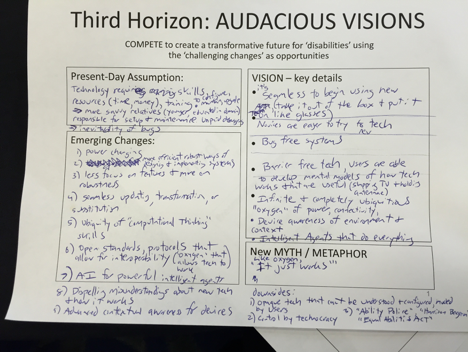The facilitator began with the third horizon, explaining that it represented the positive potential of emerging changes.

Overturning “Business as usual” Thinking
The Three Horizons Framework was used to build exploratory futures or visions (preferred futures) based on emerging changes identified on Day One of the Summit; as presented by the authors and respondents, and discussed as a group.
Based on consensus building, the attendees narrowed and then pinpointed several “vulnerable assumptions” to be further explored. Each assumption was assigned a roundtable consisting of a small working group (5-7 people) which was self-selected. To begin the exercise these small working groups took a current status quo assumption to break and turn into an audacious vision. They tackled one of the “vulnerable assumptions” and collaboratively envisioned a transformative, inclusive future/audacious vision. Using their ‘challenging changes’ as opportunities they identified emerging changes that could catalyze and/or galvanize their future, developed the key details and characteristics of their vision, and then created a new myth or metaphor for the future. For example, the assumption that technology adoption and meaningful use requires technical skill and training was given the new metaphor, “Like oxygen, it just works.” Exercise worksheets were provided to each group to facilitate capturing their ideas. Working groups presented the visions in five bullet points and those that were determined to be the most novel and transformative were selected to go onto the next phase that would build common visionary themes.
As the facilitator, Dr. Schultz, pointed out “organizations often become vulnerable when they take the present for granted. People assume that their current working assumptions will remain robust over time – yet emerging change is steadily eroding those assumptions.” Participants began by quickly brainstorming an inventory of current working assumptions, business models, stakeholder relationships, infrastructure, etc. What is the current state of play? How have the current working assumptions, business models, and infrastructure arisen from past experiences – and how are the past and present constraining new ideas and practices? They discussed emerging technologies, social and change process factors that challenged the “assumption” in order to build a path to a transformative future for people with disabilities.
Summit participants identified the following ideas that are established thinking at the intersection of disability; technology design, production and deployment; and culture.
Assumptions:
- We don’t need to design for people with disabilities because they’re not that many
- What’s the business case?
- What is minimum compliance?
- Things will be hard and frustrating
- Insurance companies will always struggle with reimbursement for general use technology that are used in a assistive manner
- Cost kills Access to Assistive Technologies (AT)
- Not enough outreach in American Sign Language (ASL) awareness
- Accessibility is too hard, let’s fix it later
- Persons without disabilities don’t appreciate daily challenges of those with disabilities
- Disability growing, accommodations not keeping up
- Old AT models are good enough, why change?
- Economic disparities will persist
- “Us” versus “Them” situation will persist due to multiple divides rich-poor- with disability, without a disability, language divide
- People with disabilities will always need a caregiver
- Marginalization will always exist
- Political tied to medical outcomes rather than social outcomes
- People love their fragmented silos, my way or the highway
- Perception of disability as a family burden
- Barriers in the environment will always create disability
- Assumption that disability has a greater impact on productivity, mobility and thus creates a disability closet culture.
- Assume aging parents will want functional independence
- Presume that people with disabilities want to be included
- People believe that just because they did something for a person with a disability then they did something great – you should be grateful
- That someone with a disability doing anything is inspirational / heroic







